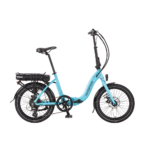Looking at the dates of the statutes quoted they mostly were brought in before the UK became part of the EU.Unfortunately it's not. This is Statute Law, so the onus is on the manufacturer (who may be the person that fits a kit to a bike) to prove that the motor can only deliver 200W output, as defined by the method described in BS1727:1971.
If you want chapter and verse then this is what the Road Traffic Act (in UK SI 1168, the EAPC Regulations) gives as definitions, quote:
"2. In these Regulations—
“continuous rated output” has the same meaning as in the 1971 British Standard;
“kerbside weight”, in relation to an electrically assisted pedal cycle, means the weight of the
cycle without any person on it and with no load other than the loose tools and equipment with
which it is normally equipped;
“nominal voltage” means the nominal voltage of the battery as defined in the 1971 British
Standard;
“the 1971 British Standard” means the specification for motors for battery operated vehicles
published by the British Standards Institution under the reference 1727: 1971 as amended by
Amendment Slip No. 1 published on 31st January 1973, Amendment Slip No. 2 published on
31st July 1974 and Amendment Slip No. 3 published on 31st March 1978;"
and this is what it actually says with regard to the requirements, quote:
"4. The requirements referred to in Regulation 3 above are that the vehicle shall:—
(a) have a kerbside weight not exceeding—
(i) in the case of a bicycle, other than a tandem bicycle, 40 kilograms, and
(ii) in the case of a tandem bicycle and a tricycle, 60 kilograms;
(b) be fitted with pedals by means of which it is capable of being propelled; and
(c) be fitted with no motor other than an electric motor which—
(i) has a continuous rated output which, when installed in the vehicle with the nominal
voltage supplied, does not exceed—
(A) in the case of a bicycle, other than a tandem bicycle, 0.2 kilowatts,
(B) in the case of a tandem bicycle and a tricycle, 0.25 kilowatts; and
(ii) cannot propel the vehicle when it is travelling at more than 15 miles per hour."
These parts of the law have to be read in conjunction with the parts of The Pedal Cycles (Construction and Use) Regulations 1983, in UK SI 1176, quote:
"Interpretation
3. - (1) In these Regulations:-
(a) a reference to the manufacturer of a vehicle means, in the case of a vehicle which has been so altered so as to become an electrically assisted pedal cycle, the person who made that alteration;"
This law also states:
"4. No Person shall ride, or cause or permit to be ridden, on a road a pedal cycle to which the Electrically Assisted Pedal Cycles Regulations 1983 apply unless it is fitted with -
(a) a plate securely fixed in a conspicuous and readily accessible position showing:-
(i) the name of the manufacturer of the vehicle,
(ii) the nominal voltage of the battery (as defined in the 1971 British Standard) of the vehicle, and
(iii) the continuous rated output (as defined in the 1971 British Standard) of the motor of the vehicle;"
From this you can see that before you fit the plate to the bike with the rating, you have to ascertain the motor power and battery voltage according to the BS, you can't do this afterwards as otherwise the information on the plate would be, in effect, made up, rather than measured, as required.
Since we became subject to EU law, that takes preference over UK law, I believe all electrical goods sold in the EU have to be marked with a CE approval badge.
Certainly my own Storck motor is so marked and having had a quick look at other electrical goods in my house they all seem to be marked as CE approved to whatever that particular standard is.
I think the law requires the importer of goods from outside the EU to ensure the goods comply with regulations not the end user. Assuming the end user uses the electrical items for the use determined by the supplier.






